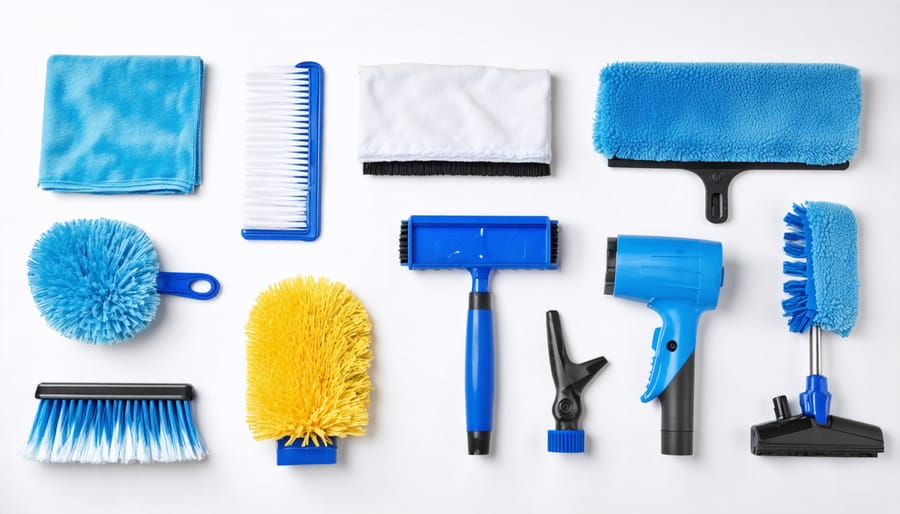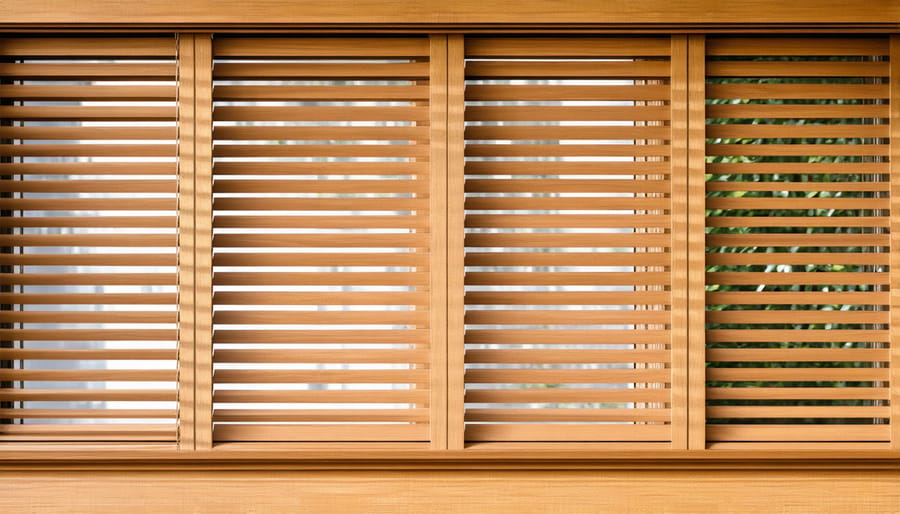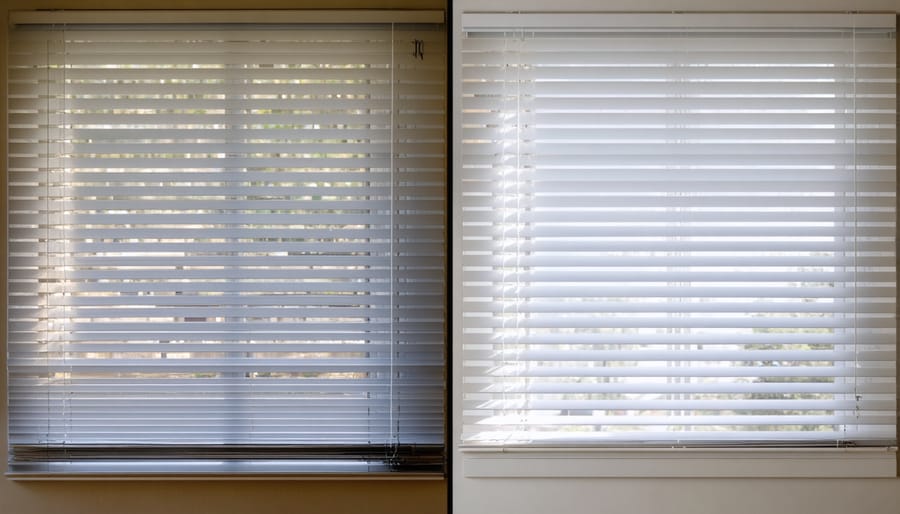Transform dusty, grimy window blinds into spotless fixtures with proven cleaning techniques that protect your investment. Regular blind cleaning not only enhances your home’s appearance but also extends the life of your window treatments and improves indoor air quality. Whether you’re tackling vinyl, wood, or fabric blinds, the right approach makes all the difference. From quick weekly maintenance to deep seasonal cleaning, these expert-tested methods will help you achieve professional-level results without damaging your blinds – and most solutions use common household items you already have on hand. Skip the costly replacements and restore your blinds to their original beauty with these time-saving, effective cleaning strategies tailored to every type of blind material and level of dirt accumulation.
Essential Tools for Blind Cleaning Success
Must-Have Cleaning Tools
To effectively clean your window blinds, you’ll need a few essential tools in your cleaning arsenal. Start with a high-quality microfiber cloth, which is gentle yet effective at trapping dust and dirt. A soft-bristled duster, preferably with an extendable handle, helps reach those tricky high spots without strain. For thorough cleaning sessions, like those mentioned in our professional window cleaning secrets, consider investing in a vacuum cleaner with brush attachments specifically designed for blinds. A sock worn as a glove can work surprisingly well for quick dusting between deep cleans. Don’t forget to keep a spray bottle of gentle cleaning solution and a few clean, dry microfiber cloths handy for tackling stubborn spots. For wooden blinds, a wood-specific cleaner is essential to maintain their finish and prevent damage.

Cleaning Solutions for Different Blind Materials
Different blind materials require specific cleaning approaches to maintain their beauty and durability. For wooden blinds, use a slightly damp microfiber cloth with a gentle wood cleaner or a mix of warm water and mild dish soap. Avoid excessive moisture, as it can warp the wood. Vinyl blinds are more tolerant of moisture and can be cleaned with natural cleaning solutions like vinegar and water or all-purpose cleaners. For fabric blinds, start with gentle vacuuming using the brush attachment. Spot clean with a mild soap solution, being careful not to saturate the fabric. Always test any cleaning solution on a small, hidden area first to ensure it won’t cause discoloration or damage. For delicate or expensive materials, consider professional cleaning services to maintain their quality and extend their lifespan.
Cleaning Techniques by Blind Type
Wooden Blind Care
Wooden blinds add a touch of elegance to any room, but they require special care to maintain their beauty and durability. Start by dusting your wooden blinds regularly with a soft microfiber cloth or a feather duster, working from top to bottom to prevent dirt from falling onto clean slats.
For deeper cleaning, create a gentle solution using warm water and a few drops of mild wood soap. Never soak wooden blinds, as excess moisture can cause warping or discoloration. Instead, slightly dampen a cloth with the solution and wipe each slat individually, followed immediately by a dry cloth to prevent water damage.
Pay special attention to any grease spots or stubborn stains. For these, use a wood-specific cleaning product and test it on a small, hidden area first. Avoid using all-purpose cleaners or harsh chemicals that might strip the wood’s finish.
To protect your wooden blinds long-term, apply a thin coat of furniture polish every few months. This helps prevent dust accumulation and maintains the wood’s natural luster. Remember to clean your blinds with closed slats first, then adjust them and clean the opposite side.

Vinyl and Aluminum Blind Maintenance
Vinyl and aluminum blinds are among the most common window treatments, and thankfully, they’re relatively easy to maintain. For regular cleaning, use a microfiber duster or soft cloth to wipe down each slat, working from top to bottom. Tilt the blinds in both directions to ensure you clean both sides thoroughly.
For deeper cleaning, mix warm water with a mild dish soap. Dip a soft cloth or sponge into the solution, wring it out well to avoid drips, and wipe each slat individually. For stubborn spots, you can use a mixture of equal parts white vinegar and water. Remember to be gentle – while these materials are durable, excessive pressure can bend or damage the slats.
If your blinds are particularly grimy, you can actually remove them and clean them in the bathtub. Fill the tub with warm, soapy water and let them soak for about 15 minutes. Afterward, rinse thoroughly with clean water and dry completely before rehanging to prevent water spots or rust on aluminum blinds.
For quick maintenance between deep cleanings, use dryer sheets to wipe down the slats – this helps reduce static and repel dust.
Vertical Blind Cleaning Strategies
Vertical blinds require a gentler approach compared to their horizontal counterparts, but don’t let that intimidate you! Start by fully extending your vertical blinds and rotating the slats to their most accessible position. For a quick refresh, use your vacuum’s brush attachment on low power, moving from top to bottom along each slat.
For deeper cleaning, prepare a solution of warm water and mild dish soap. Take a soft microfiber cloth, wring it out well (excess water is the enemy here!), and gently wipe down each slat from top to bottom. Pay special attention to the bottom edges where dust tends to collect. If your blinds are particularly grimy, you might need to go over them twice.
For spot cleaning stubborn stains, use a slightly dampened magic eraser, but test it first on an inconspicuous area. Never use harsh chemicals or abrasive cleaners, as these can damage the protective coating on your vertical blinds.
Pro tip: Keep your vertical blinds looking fresh longer by running a dryer sheet over them after cleaning – this helps repel dust and static electricity!
Fabric and Cellular Shade Care
Fabric and cellular shades require special attention due to their delicate materials. For fabric shades, start with regular dusting using a feather duster or vacuum with a soft brush attachment on low power. Work from top to bottom in gentle, horizontal strokes to prevent damaging the material.
For deeper cleaning, spot-clean stains using a mild soap solution and a clean white cloth. Never saturate the fabric, as this can lead to water marks or fabric deterioration. Instead, blot the stained area gently and allow it to air dry completely before raising the shade.
Cellular shades need an especially gentle touch to maintain their honeycomb structure. Use compressed air to blow out dust from the cells, holding the can about 6 inches away. For stubborn dirt, try using a hair dryer on the cool setting to dislodge debris. If spot cleaning is necessary, use a very small amount of mild detergent mixed with water, applying it with a clean white cloth. Always test any cleaning solution on an inconspicuous area first.
To prevent excessive dirt buildup, dust your shades every two weeks and avoid installing them in high-moisture areas like bathrooms or above kitchen sinks.
Quick Maintenance Tips

Weekly Quick-Clean Routine
Keeping your blinds dust-free doesn’t have to be a massive chore. By following a simple weekly routine, you can maintain clean blinds with minimal effort. Start by closing your blinds completely, then use a microfiber duster or cloth to wipe each slat from left to right. Work from top to bottom to avoid redistributing dust onto already-cleaned areas.
For horizontal blinds, tilt the slats in the opposite direction and repeat the process to clean both sides. For vertical blinds, gently wipe down each slat from top to bottom. If you spot any stubborn marks, dampen your microfiber cloth slightly with water and give those areas extra attention.
Make this quick clean part of your regular housekeeping routine – perhaps every Sunday morning or whenever you do your weekly dusting. This simple 5-minute task will prevent heavy dust buildup and reduce the need for deep cleaning sessions later on. Remember to keep your cleaning tools nearby for easy access and consistency.
Preventing Dust Build-up
Regular maintenance is key to keeping your blinds dust-free for longer periods. Start by using your HVAC system’s air filter regularly and replacing it every 3-4 months to help improve your home’s air quality and reduce dust accumulation. Consider running an air purifier in rooms with blinds, especially during peak pollen seasons or in dusty environments.
Create a weekly dusting schedule using a microfiber duster or dryer sheets, which help repel dust thanks to their anti-static properties. After showering, keep your bathroom window blinds open to prevent moisture build-up, which can trap dust particles. During cleaning sessions, apply a light coating of fabric softener solution (one part softener to four parts water) to your blinds – this creates a dust-resistant barrier that makes future cleaning easier.
For rooms facing high-traffic areas or construction sites, keep windows closed during peak dust hours and use window screens as an extra barrier. These simple preventive measures can significantly reduce your cleaning frequency while maintaining spotless blinds.
Troubleshooting Common Cleaning Problems
Even the most diligent cleaning routine can sometimes encounter challenging situations. If you’re facing yellowed or deeply stained blinds, try mixing a solution of one part white vinegar with two parts warm water. Apply this mixture with a microfiber cloth and let it sit for about 5 minutes before wiping clean.
For stubborn grease stains, especially common in kitchen blinds, create a paste using baking soda and water. Gently apply the paste to the affected areas, let it sit for 10-15 minutes, then wipe away with a damp cloth. Remember to test any cleaning solution on a small, hidden area first to ensure it won’t damage your blinds.
Dealing with mold? Mix equal parts water and white vinegar, adding a few drops of tea tree oil for extra antimicrobial power. Apply the solution carefully, then dry thoroughly to prevent future mold growth. For blinds that have become sticky due to cooking residue, a mixture of dish soap and warm water usually does the trick.
If your metal or plastic blinds have rust spots, try rubbing them gently with a paste of lemon juice and cream of tartar. For wooden blinds with water spots, a solution of equal parts olive oil and white vinegar can help restore their appearance while conditioning the wood.
Remember, prevention is better than cure – regular dusting and prompt attention to spills will help avoid most stubborn cleaning problems.
Maintaining clean window blinds doesn’t have to be a daunting task when you have the right approach. By following the cleaning methods we’ve discussed, you can keep your blinds looking fresh and functioning properly for years to come. Remember to dust regularly, deep clean as needed, and always consider your blind’s material when choosing cleaning products and techniques. Making blind maintenance part of your routine cleaning schedule will prevent dust buildup and make the task more manageable. Whether you’re dealing with vinyl, wood, or fabric blinds, gentle care and consistent attention are key to preserving their appearance and extending their lifespan. Set a reminder to clean your blinds every few weeks, and you’ll enjoy clearer views and a fresher home atmosphere while protecting your investment in these essential window treatments.
